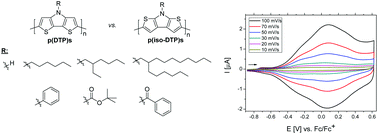Synthesis and characterization of two isomeric dithienopyrrole series and the corresponding electropolymers†
Abstract
Synthesis and electropolymerization of 4H-dithieno[3,2-b:2′,3′-d]pyrrole (DTP), isomeric 7H-dithieno-[2,3-b:3′,2′-d]pyrrole (iso-DTP), and their N-functionalized analogues (R = hexyl, 2-ethylhexyl, 2-hexyldecyl, phenyl, tert-butyloxycarbonyl, or benzoyl) are presented. Changing the relative positions of the sulphurs in DTPs leads to cross-conjugated iso-DTPs with decreased HOMO and increased LUMO energy levels in the monomers and stabilized frontier molecular orbitals in the polymers. In particular, conjugated substituents exhibit a stronger electronic influence on the LUMO energy levels than non-conjugated moieties in monomers and polymers of the two series, respectively.



 Please wait while we load your content...
Please wait while we load your content...